| |
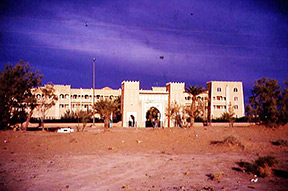 |
|
| |
Hotel El Ati Erfoud in Morocco |
|
| |
|
|
| |
In the lobby of the El Ati kasbah-like hotel in Erfoud, Morocco’s tourist-desert city, I was having a conversation with John, an Englishman who called himself a modern troubadour. He had just made a trip through the Dades Valley and Canyon where kasbahs dot the landscape. When I asked what he thought of these trademarks of Morocco, he answered in poetry:
|
|
| |
Kasbahs, melting under torrential rain,
Kasbahs repaired to rise and live again,
Kasbahs sprouting new, small and grand,
Fairytale forts, built by magical hands.
|
|
| |
The next morning, retracing John’s trip in reverse, our group of five were in a good mood as we made our way westward from Erfoud to explore the land saturated with kasbahs. Even though we had seen many of these mud castles and new modern structures in their image along the Ziz Valley from the towns of Errachida and Erfoud, I knew there were many more to the west—the true land of kasbahs. |
|
| |
|
|
| |
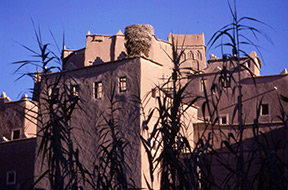 |
|
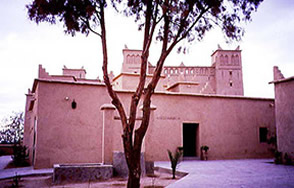 |
|
| |
Ouarzazate kasbah-like structures |
|
Kasbah in Dades Valley |
|
| |
|
|
|
|
| |
It is believed that the Arab tribes which came from the Yemen brought with them the art of building kasbahs. This is quite certain since in northern Yemen the same type of fortress-castles are still being constructed.
In the oases land of southern Morocco this form of building took hold. Built from the soil of the countryside which is mixed with straw, kasbahs cost very little—ideal for people who have hardly any money to spare. They fuse traditional Berber battlement exterior building techniques with finely decorated interiors inspired by the Andalusian palaces of Moorish Spain. Men of modest means construct their small homes kasbah-style, while the powerful and affluent erect huge fortress structures which are the true kasbahs. |
|
| |
|
|
| |
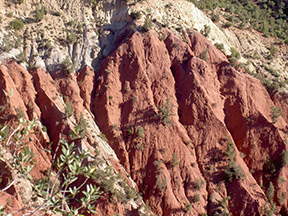 |
|
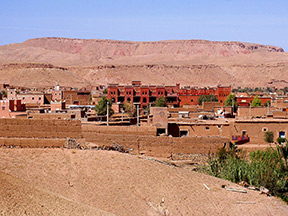 |
|
| |
High Atlas rock formations |
|
HighAtlas village near Ouarzazate |
|
| |
|
|
|
|
| |
A decade before, I had travelled across southern Morocco’s mountains to see these appealing structures. However, it was only a brief visit. This time I planned to make a more extensive tour of these structures which rise majestically in the shadows of the High Atlas Mountains.
After a leisurely three hour drive through a sparsely settled semi-desert land, we reached Tinerhir—a rich agricultural town of 10,000, some 160 km (100 mi) west of Erfoud. Set in a fertile valley amidst some of the most beautiful landscape in Morocco, it is the door to the Todra Gorges, Morocco's most famous natural wonder. |
|
| |
|
|
| |
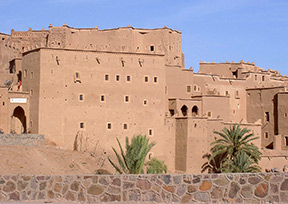 |
|
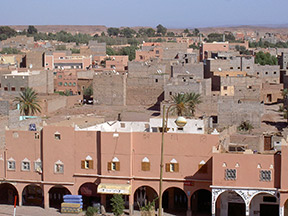 |
|
| |
High Atlas Ouarzazate View |
|
High Atlas Ouarzazate View |
|
| |
|
|
|
|
| |
As we drove northward, our driver stopped atop a cliff to let us enjoy the splendid view of the green valley below. Thousands of fruit trees dominated by countless palms were intermixed with fields of grain. A galaxy of gold coloured kasbahs, a good number newly built, contrasting with the silver-green of the olive trees, the deep green of the date palms and the emerald green of carpet-like grain fields, made it an unforgettable sight.
A short distance onward, we reached the towering gorges—the most impressive geological formation in all Africa. Two steep limestone cliffs rose vertically through gray, green, yellow and red rock to 300 m (984 ft) and towered above the gravel base of the canyon —at its narrowest point only 10 m (33 ft) wide—through which ran a small crystal-clear stream which was reputed excellent for curing sterility in women. |
|
| |
|
|
| |
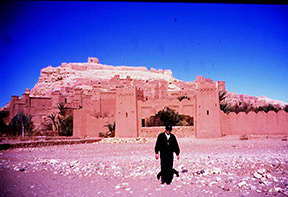 |
|
 |
|
| |
Author before the Kasbah of Tifiltou |
|
Ouarzazate Kasbah of Taourirt |
|
| |
|
|
|
|
| |
We spent an hour examining the gorge, then returned to Tinerhir to relish for awhile this oasis town situated in the heart of an overwhelming fantastic region. Nestled in a surrounding of olive, pomegranate, date palms and a large number of kasbahs, including the ruins of one of El-Glaoui*s (a former French supported war lord) mud castles, Tinerhir was well worth our fleeting visit.
Westward from Tinerhir, we drove for half an hour through a barren landscape until we reached Boumalane, noted for its fantastic looking Hotel el-Madayeq, built kasbah-style and overlooking the town. After examining this superb structure, we took the road which led to the Dades Canyon, an awesome and torturous limestone gorge with dizzying cliffs, dotted with truly bizarre rock formations resembling melted wax formed on the sides of candles. It was a rough, jagged universe, defusing a mixture of mauve, purple, red and a myriad of colours. |
|
| |
|
|
| |
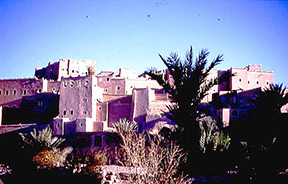 |
|
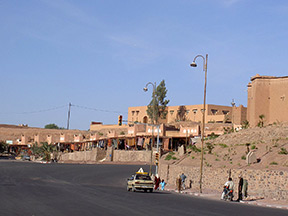 |
|
| |
Kasbah-like structures, Ouarzazate |
|
High Atlas, Ouarzazate |
|
| |
|
|
|
|
| |
Carved by the Dades River thousands of years ago in eerie, but breath-taking shapes of eroded limestone, the canyon is lined with innumerable kasbahs built by chieftains in the past ages. These mud fortresses of the strong seemed to be everywhere. Their adobe walls and squat towers are fine examples of Arab influenced Berber art whose motifs are seen on the local carpets, jewelery and pottery.
As we looked down from our twisting road to the valley below, it seemed that the grass was greener, the soil redder and the kasbahs more appealing than those outside the valley. The fantastic colours of the stone cliffs contrasting with the valley green and towering kasbahs had us enthralled and gave us a feeling that we were in a fairyland of enchantment.
Back from Boumalane we drove westward, following the Dades valley, a thin line of green in a barren world, called the ‘Valley of a Thousand Kasbahs’. Between Boumalane and Kelaa M’Gouna, our next stop, the road was lined on both sides with kasbah style buildings, many newly built. Until we reached the Kelaa M’Gouna, the whole route appeared to be one continuous town. |
|
| |
|
|
| |
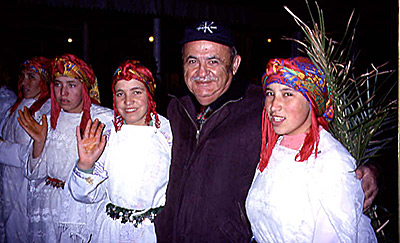 |
|
| |
Author with dancers, Dades Valley |
|
| |
|
|
| |
The Kelaa, 2,000 m (6,560 ft) above sea level, called the rose garden of the Dades Valley, is a magnificent and superb place and the centre of a fertile rose-growing oasis. In the 1920s, the French introduced the Damascus rose from Syria into this valley where it thrived. In spring, the fragrance of these flowers intermingled with those of the fruit and nut trees, make it an enchanted region.
Travellers have written that in May and June, at the time of the Rose Festival, the countryside around the Kelaa is completely covered with roses whose aroma hangs heavily over the countryside and the town itself. Perfumes from the fruit orchards, almond trees, and grape fields smothered by rose hedges produce a feeling of heavenly seduction.
For a short distance west from the Kelaa, the highway was edged on both sides by greenery and imposing kasbahs and new kasbah-like homes, but soon we were driving in an arid landscape until we reached Skoura, a luxurious oasis famous for its roses which thrive amid grain fields and palm trees. Here we stopped awhile to admire a number of kasbahs and newly erected kasbah-like buildings which could be seen from the roadway. |
|
| |
|
|
| |
 |
|
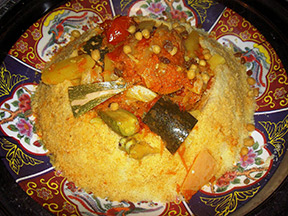 |
|
| |
High Atlas, Ouarzazate |
|
Chez Ali couscous |
|
| |
|
|
|
|
| |
West from Skoura, we drove through a countryside full of dry river-beds, under the shadows of the snow-capped High Atlas Mountains looming in the distance. We soon reached Ouarzazate, built by the French as a garrison town in the heart of Morocco's Great South on the road to the land of the kasbahs. Located at the crossroads of the Draa, Dades and Sous Valleys, the town is encircled by a barren landscape and overshadowed by the snow-capped Atlas.
A provincial capital of about 50,000 inhabitants, whose setting is romantically scenic, it is an important pre-Saharan crossroad—an ideal point from which to set out on journeys of discovery to the valleys of the kasbahs both to the south and east. Even though it offers all the amenities of a modern city , everything appears to be tranquil and fresh. Called the ‘pearl of the sands’ and vibrant and expanding, it appears to have a bright tourist future. |
|
| |
|
|
| |
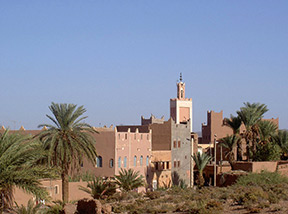 |
|
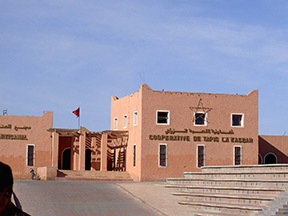 |
|
| |
High Atlas, Ouarzazate |
|
Ouarzazate tourist trap |
|
| |
|
|
|
|
| |
Here, we spent two days exploring the many kasbahs in town and on its outskirts. The prominent of these was Tifiltout, one of El Glaoui's kasbahs, parts of which have been renovated, and his other kasbah, Taourirt, considered to be the mother of all kasbahs. Encompassing a series of crenelated towers, rising out of a mass of closely packed houses and lavishly decorated with geometric motifs, it is one of the most beautiful in Morocco.
At one time, it was on the edge of the city, but swiftly it is being surrounded by the modern town. One of the many abodes of this once powerful Lord of the Atlas Mountains, it is today a tourist stoppingplace where part of the movie Jewel of the Nile was filmed. |
|
| |
|
|
| |
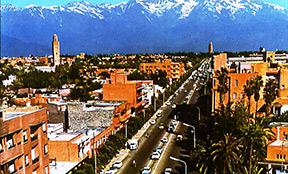 |
|
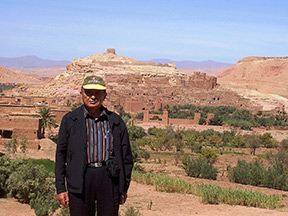 |
|
| |
Marrakesh |
|
Author at Aït Benhaddou |
|
| |
|
|
|
|
| |
Leaving Ouarzazate we stopped at the Atlas Cinema Studio where a great number of films are shot, then continued to the kasbah-town of Aït Benhaddou. From a distance, its kasbahs and homes looked magnificent. However, as we strolled through its narrow alleyways we found that the town was in ruins. A small section has been restored by UNESCO which declared this ruined town ‘a world heritage site’. Only 8 families now live within its walls, where a few decades ago there were hundreds. The village is on the itinerary of tourists because of its filming appeal. Parts of movies like ‘Gladiators’, ‘Sodom and Gomorrah’, Jesus of Nazareth’, ‘Lawrence of Arabia’ and ‘The Jewel of the Nile', filmed in this decaying ksar, made it important site to see.
After leaving Aït Benhaddou, we headed for Marrakesh. As it is with all journeys, the route back to the modern world lost the excitement of something new over the horizon. Our group all felt sad that our excursion through the mountains and valleys filled with kasbahs had come to an end. However, I was sure that memories would remain of that fantastic journey. |
|
| |
|
|
| |
|
|
|
|
|

